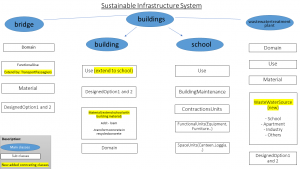Concept and Introduction:
The four civil engineering systems we developed individually are:
– a school building
– an apartment building
– a (railway-)bridge
– a wastewater treatment plant.
All combined logically together they form the system: sustainable infrastructure system.
All four buildings depict key elements of a populated region.
On the one hand, the railroad bridge enables sustainable transport and mobility within the city and, on the other hand, it provides a connection to the “outside world” to ensure the import of resources. In contrast to local mobility by car, less co2 emissions are emitted by the shared use of public transport such as trains.
The next core element is the apartment house, which is a dwelling for the population living in the area. In the most sustainable case, built by using wood and clay, capturing Co2 and at the same time not emitting much.
Then the school, which is a learning and education space, because only through education and information can come next generations, which is more conscious of resources and advocates for a sustainable just world.
And furthermore, the wastewater treatment plant. This can filter and purify all the wastewater from the individual buildings in order to discharge it back into receiving waters. In addition, to fulfill the sustainability aspect, it can also treat gray water in order to make it usable for agriculture.
The main intention of our interconnected system is to provide a system that reflects the basic elements of an (urban) infrastructure in order to expand it according to requirements and boundary conditions. In addition, sustainability aspects related to rail transport, construction materials and wastewater treatment and reuse are also taken into account.

Figure 1: First Concepts of how integrating all models together